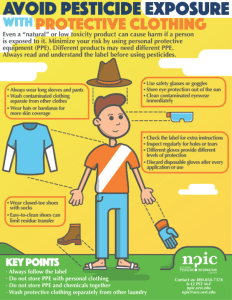Hello Avid Readers!! Thank you for coming back for Pesticide Safety Education Month. We will have a series of blogs this month covering one of our favorite topics Personal Protective Equipment or PPE. The series begins today with an introduction to PPE and provision of resources on the subject. It continues next week with a description of the major components of PPE and assembly of a PPE kit. Later this month our Director, Dr. Jason Ferrel, will describe several easy and imperative methods for maintaining various PPE. Finally, Dr. Brett Bultemeier will wrap up the series with a message on where PPE are listed in the label and labeling to help applicators stay in compliance.
What is PPE?
The PIO has been singing the tune of PPE for literal years. PPE is an applicators main source of protection from pesticide exposure. This is because a pesticide’s risk is a function of exposure and the pesticide’s toxicity (Risk = Exposure + Toxicity). Exposure refers to how much of the product an applicator was subjected to. In other words how much pesticide got in or on the body. Toxicity refers to the amount of the product that is poisonous. Therefore, using the right PPE can reduce exposure to and overall risk from pesticides. Next week different types of PPE will be discussed in detail. If you just can’t wait check out the EDIS document PPE for Handling Pesticides.

Why is PPE Important?
Again, PPE is important because it can prevent exposure to pesticides. The PIO blog, PPE Is it a Costume or Invincible Armor discusses this topic and we’ll review some main points of exposure here.
Oral exposure may occur via eating, drinking, or smoking if an applicator has not washed their hands. One should not eat anything from agricultural fields or off fruit trees in areas where pesticides are used.
Dermal exposure occurs when pesticides enter the human body through the skin. This is how most pesticide agricultural pesticide injuries occur. This is important to prevent as some pesticide products can enter through the skin and pass into the bloodstream.

Ocular exposure occurs when pesticides get into the eye or eyes. It is possible for this to occur by splashing during mixing, drift, or from hands to eyes. This can cause irritation at the least or permanent damage at worst.
Inhalation exposure occurs when pesticides are inhaled into the lungs. This is also referred to as respiratory exposure. This can occur from pesticide drift if a respirator is not worn.
Does it Fit?
PPE is no good if it isn’t worn properly. It is important that the glove fits so to speak. Try on your PPE before heading out into the field. Ensure you can walk freely in pesticide resistant clothing, that your respirator fits properly, and that gloves and other items are comfortable. Check out our previous commentary on this topic through our blogs Making PPE More Comfortable and Personal Protective Equipment: One Size Does not Fit all .

Summary
PPE is a vital component of pesticide safety. It can help to reduce exposure and overall risks associated with pesticides. Please stay tuned in to our series! Next week come back as we discuss the main pieces of PPE and how to assemble a PPE kit. Our third blog of the series will cover maintenance of PPE. Protection is only as good as the equipment! Don’t forget to hang in for our final week and summary with a blog on pesticide labels and labeling, and where an applicator would find the required PPE. Prepare for this last by reviewing our blog on “What PPE do I Need?”
SUBSCRIBE TO OUR BLOG
Additional Resources
Note: All images and contents are the property of UF/IFAS.



